Thermaltake Armor A30 Case Review: Opening the Puzzle Box
by Dustin Sklavos on September 24, 2012 12:01 AM EST- Posted in
- Cases/Cooling/PSUs
- Thermaltake
- MicroATX
Noise and Thermal Testing, Dedicated GPUs
While the Zotac GeForce GTS 450 I typically add to smaller cases for testing tends to not cause too much of a racket or an increase in thermals, the GTX 560 Ti I've taken to using to test the more ambitious designs can create a very notable change. Given the pleasant surprise of the Thermaltake Armor A30's thermals and acoustics, I was curious to see if it would hold up under the increased stress. It did.
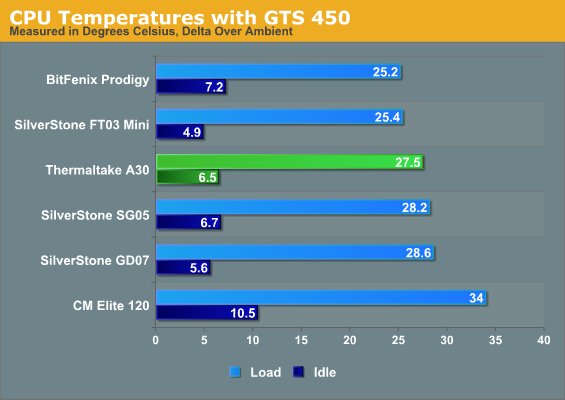
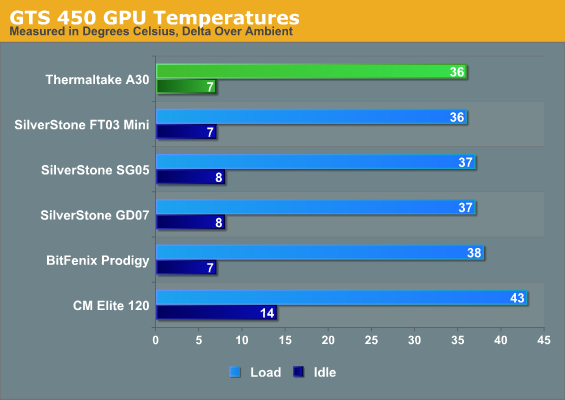
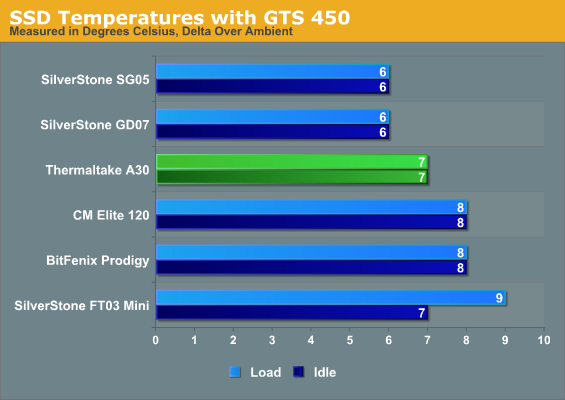
Once again, thermals in the A30 were competitive with the best of the smaller cases we've tested. It's clear the GTS 450 isn't adding a tremendous amount of stress to the situation.
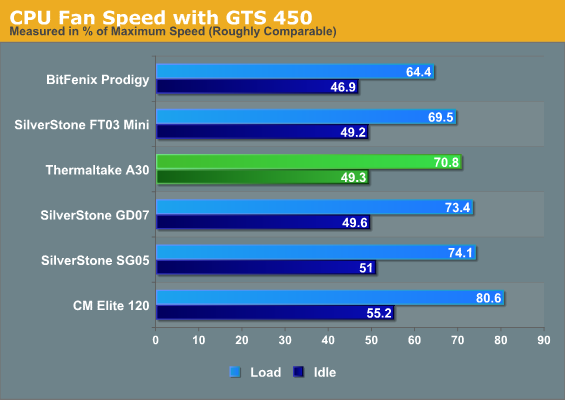
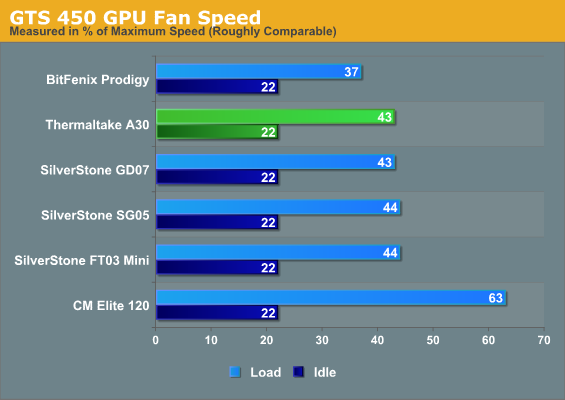
That sentiment is echoed when we look at the fan speeds; only the Prodigy and its...err...prodigious intake fan is able to best the rest of the pack.
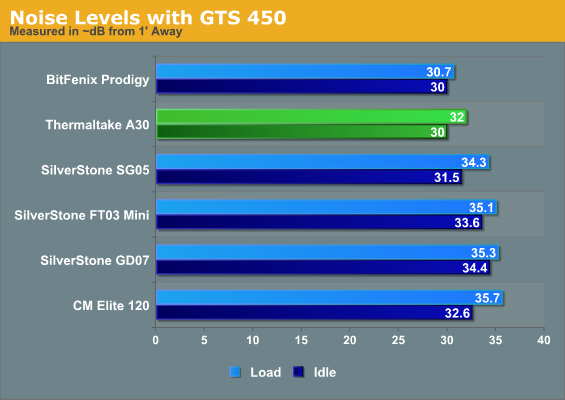
Under load the A30 is the second quietest behind the Prodigy; Thermaltake continues to impress. It's obvious an i3 and a single-slot, low-power GTS 450 aren't enough to really push this case, so let's see what happens when we install the much beefier GeForce GTX 560 Ti.
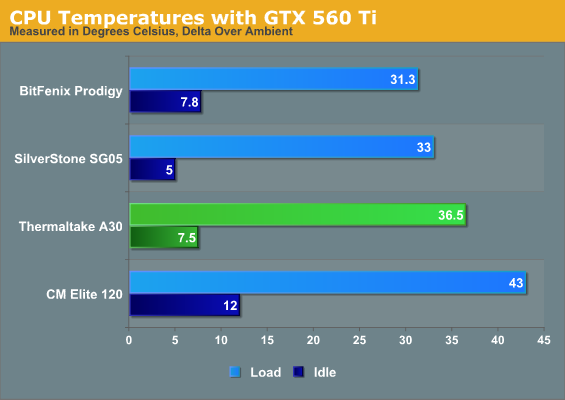
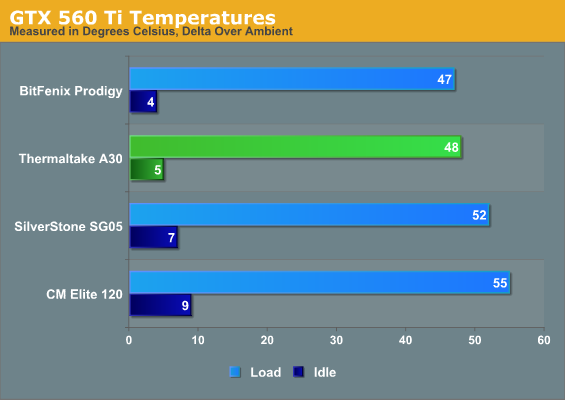
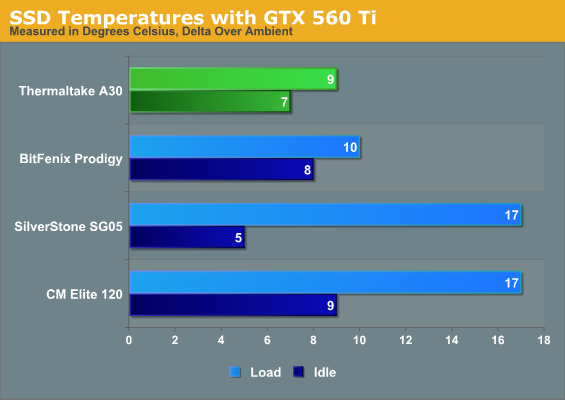
Things begin to separate but again, the A30's performance isn't bad at all. The SSD continues to experience very little heat due to its distance away from the heat-generating components; it doesn't get much airflow, if any, but doesn't need it as so little heat is really being trapped where it is.
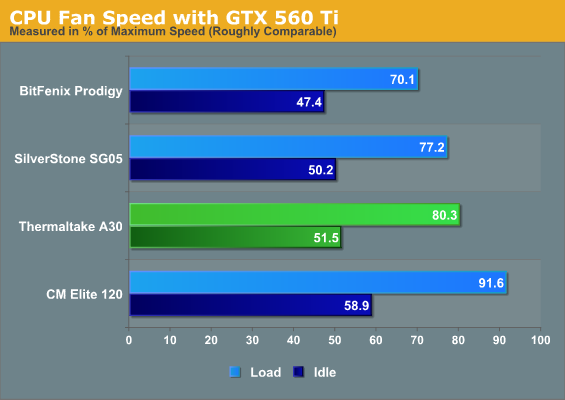
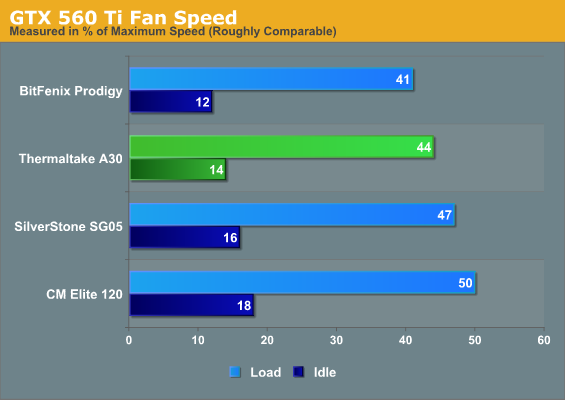
The A30's cooling design continues to be a pretty big winner. While the GTX 560 Ti isn't getting too much active airflow from the case itself, it has access to enough open space between it and the wall of the case (plus the ventilation near the top) to perform reasonably well.
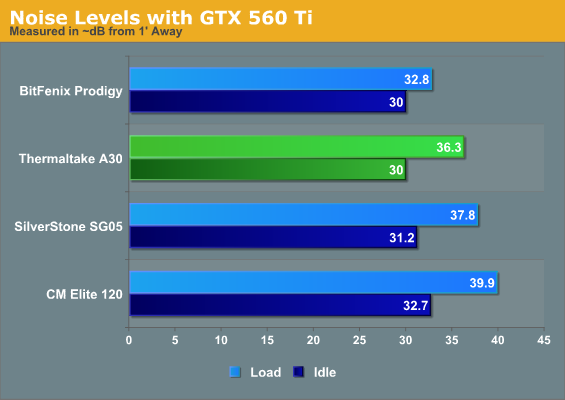
In my opinion, this is the A30's big victory. Acoustically it's still reasonably quiet, and though it can't compete with the Prodigy's size and thermal design, it's plenty competitive with the other cases we've tested. That said, it's important to keep in mind that it's also substantially bigger than the SilverStone SG05 (though I'd argue it doesn't make as efficient use of its space as SilverStone's design does).










26 Comments
View All Comments
Ryomitomo - Monday, September 24, 2012 - link
I have recently built an i7-3770K + GTX680 system with the A30 case for my brother-in-law. The case is not easy to build with. Tidying the wires is very hard. The top fan is placed in a weird location, the PSU blocks over half of the fan. The GTX680 power plug jabs against the metal casing for the 5.25" bays, I had to bend the power wires 90 degrees at the plug to fit them under the metal casing.However, after the system was put together carefully, I have to say it is rather quiet unit and the temperature of the CPU and GTX680 is only a few degrees higher than my Thermaltake Armor Revo case build with same CPU and GTX680.
piroroadkill - Monday, September 24, 2012 - link
I think there's a reason why the Prodigy has become popular - it looks good as well as being a mini-ITX case you could actually use for a high end machine.Meaker10 - Monday, September 24, 2012 - link
All those thumb screws, the drive cage and removable tray are based on the lanparty lite series they did. This is the same but with more fans which is why the basic design feels dated. You get used to it though and you can take it apart fairly quickly.BuffaloChuck - Monday, September 24, 2012 - link
Cube cases still are doing this upside down. They need to put the motherboard on top, and power-supply/other drives on the bottom. The MB has 95% of all connections, requirement finger-tip time, and hosts most of the changes. And, if they'd put the HDDs in a two-stack nose-to-nose config under the MB tray, sticking the connections to the outside, they'd have plenty of room for airflow between drives AND space to add more. Cubes always do this design upside down.BuffaloChuck - Monday, September 24, 2012 - link
And why can't the reviewers utilitize the space offered? Instead of proving MiniATX boards fit in MicroATX cases, why not fill 'em up and THEN do the tests? The case engineers, after all, put those drive-cages in there for a reason. USE 'EM and do REAL reviews.cjb110 - Monday, September 24, 2012 - link
Because then the stats of the 3 bay case wouldn't be comparable with the 2 bay case.I think AnandTech does a good job of mentioning if they feel utilizing the extra features would be significant positive/negative.
From this review its fairly obvious it would cope with the bay's being filled in terms of performance, but it would make the already difficult install even harder.
7amood - Monday, September 24, 2012 - link
review http://www.silverstonetek.com/product.php?pid=317 pleeeeeeeeeease.Grok42 - Tuesday, September 25, 2012 - link
I 2nd the motion. Also, the LIAN LI PC-Q25 and PC-Q16.xcomvic - Monday, September 24, 2012 - link
Is that most don't have a handle on the top of it to easily lug it around...It wouldn't have taken an engineer to figure out how to attach one easily to the top of the thing...or the side..or back....wherever. I know there's been some good cases out there WITH handles, those are real LAN cases.Orvtrebor - Monday, September 24, 2012 - link
They should have added a handle again like from their earlier cube designs.Without it whats the point of doing this case? A Silverstone TJ08-E or PS07 will better serve a microatx build, and if your going to run itx there is a wide range of superior/smaller cases.